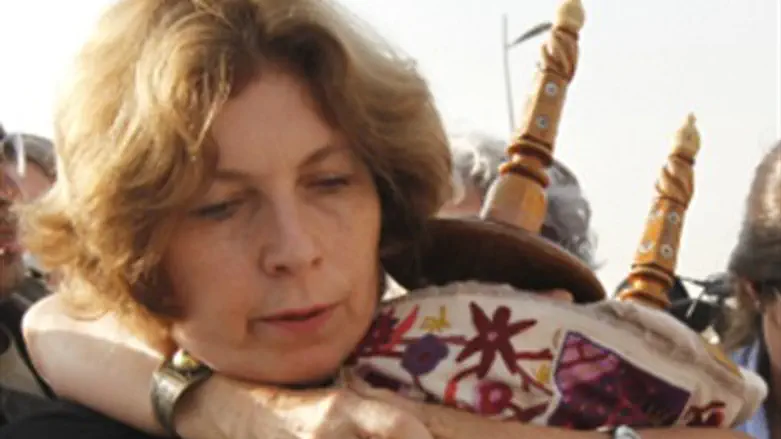
A Diaspora campaign, promoted by the NY Times, is pressuring Netanyahu to consider a radical change in traditional Jewish customs held for generations at the Western Wall, known as the Kotel in Hebrew, and and allow women to pray with men’s religious prayer shawls there.
Prime Minister Binyamin Netanyahu has stepped in to ask Jewish Agency chairman Natan Sharansky “to study the issue and suggest ways to make the site more accommodating to all Jews,” New York Times new Jerusalem bureau chief Judi Rudoren wrote Wednesday.
“The Prime Minister thinks the Western Wall has to be a site that expresses the unity of the Jewish people, both inside Israel and outside the state of Israel,” Netanyahu’s senior adviser Ron Dermer told her. “He wants to preserve the unity of world Jewry. This is an important component of Israel’s strength.”
A woman who prays regularly at the site responded to Arutz Sheva, saying that the Prime Minister did not define what "accommodating to all Jews" might entail, but that it is clear that offending the traditionally Orthodox and hareidi-religious women who are present at the holy site from dawn to dusk for prayers would not preserve unity at all - unless they are not intended to be part of that unity.
The so-called “Women of the Wall” movement, headed by Reform and some Conservative American immigrants, succeeded this past week in winning liberal media support for their cause from Rudoren.
After promoting their cause earlier this week, she followed up Tuesday with a report of “outrage” in the Diaspora over the deeply-rooted Jewish tradition to maintain modesty and protect the sexes from dropping barriers between sexes, a modern liberal trend that has encouraged a loss of family and moral values in Western countries.
The issue of women wearing a prayer shawl and reading from the Torah at the Western Wall appears on the surface to be harmless, so it has been adopted as a cause célèbre as part of the Reform and Conservative movements' decades-old attempt to destroy the Orthodox Jewish authority that dates back to the time of Moses.
The issue of confronting halakhic authority is not new in the Jewish world. The Bible describes attempts by Korach to usurp Moses’ authority because “all of the Jewish people are holy.”
Similarly, the catchy, fashionable slogan of “equality,” with a push from Rudoren, has kept the Women of the Wall’s demands on the front pages in the United States.
Previous high-profile protests by the Women of the Wall failed to convince the High Court to rule against Orthodox Jewish authority at the holy site, and the justices refused their demand to carry Torah scrolls at the Wall.
However, the court later allowed them to do so at a more isolated area, known as Robinson’s Arch, south of the Western Wall Plaza.
The effort by Reform and Conservative leaders to be accepted as equals to Orthodox rabbis is the opening shot in what is bound to be a power struggle on issues far beyond that of women’s wearing a prayer shawl.
Rudoren unintentionally revealed their goals by writing that the issue “has deepened a divide between the Jewish state and the Jewish Diaspora at a time when Israel is battling international isolation over its settlement policy.” The reform movement, as well as The New York Times, oppose Jewish rights to live in all of Jerusalem, Judea and Samaria .
Tuesday’s report included openly biased writing, stating that “particularly leaders of the reform and conservative movements in the United States, complain that the government’s recent aggressive enforcement of restrictions at the wall has turned a national monument into an ultra-Orthodox synagogue.”
There was no explanation of the term “aggressive,” and the restrictions are those that have been in force for ages and are in the rules laid down by the Kotel Rabbinate. There also is no evidence that the Western Wall is an “ultra-orthodox” synagogue. The report also ignores the existence of large Orthodox congregations of religious Zionist, Hassidic and Lithuanian yeshiva sectors in the Diaspora who are against any changes in the customs at the Kotel.
Sharansky confirmed to Rudoren that the Prime Minister asked him to study the issue, a political and religious hot potato, and that he hopes to hand in recommendations in “a few months.”
The Liberal Diaspora recently has pressured the Jewish Agency into passing a resolution calling for a “satisfactory approach to the issue of prayer at the Western Wall.”
Sharansky did not directly answer Radoren’s question if women one day will be able to read the Torah and wear prayer shawls at the Western Wall.
“I imagine very easily a situation where everybody will have their opportunity to express their solidarity with Judaism and the Jewish people and the state of Israel in a way he or she wants, without undermining the other,” he said.
Mixed men and women’s prayer service is totally unacceptable in the Orthodox community and not only among “ultra-orthodox” Jews, as mainstream media implies.
Using a prayer shawl is halakhically permitted, but is rare. It is the custom of some women in women's prayer groups or on the women's side of the synagogue in recent times, as is holding the Torah in a women's service. However, women's reading the Torah is even less prevalent in women's prayer groups and allowed only without reciting the blessings.
The Kotel, however, has special status and the overwhelming number or worshipers there are traditionally or hareidi Orthodox, groups that vehemently oppose those changes and who represent continuity in custom and observance..